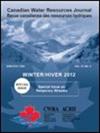2012-2016年萨斯喀彻温省土著和农村社区饮用水咨询定量分析
IF 0.9
4区 环境科学与生态学
Q3 WATER RESOURCES
引用次数: 2
摘要
摘要本研究补充了关于土著和非土著小型饮用水系统差异的现有文献。该团队采用了定量方法,并根据萨斯喀彻温省2012年至2016年4年的饮用水咨询数量,评估了季节性、地点和社区类型之间的关系。通过比较类似规模的土著和非土著社区,使用通用的估计方程来确定有助于饮用水咨询可能性的重要因素。结果表明,季节以及社区类型和地区之间的相互作用(北方与南方)在咨询计数模型中是显著的。北方保护区社区的饮用水咨询数量是南方保护区的5.19倍,是南方城镇的2.63倍,是南部村庄的4.94倍。其他比较表明,北部保护区的咨询数量是北部村庄的2.43倍,但该省南部城镇的咨询数量却是南部保护区的1.98倍,是南部村庄的1.88倍。这项工作证实了北方土著社区的风险增加,并表明萨斯喀彻温省农村和全球有必要加大对水资源安全的关注和投资。本文章由计算机程序翻译,如有差异,请以英文原文为准。
A quantitative analysis of drinking water advisories in Saskatchewan Indigenous and rural communities 2012–2016
Abstract This study complements the existing literature on disparities associated with Indigenous and non-Indigenous small drinking water systems. The team took a quantitative approach and assessed relationships between seasonality, location, and type of community against the number of drinking water advisories in Saskatchewan for a 4-year period from 2012 to 2016. Generalised estimating equations were used to determine significant factors contributing to the likelihood of drinking water advisories comparing Indigenous to non-Indigenous communities of similar sizes. Results indicated that the season and the interaction between community type and region (north vs. south) were significant in the model for counts of advisories. Reserve communities in the north had a drinking water advisory count that was 5.19 times greater than those of reserves in the south, 2.63 times greater than counts for towns in the south and 4.94 times greater than those of villages in the south. Additional comparisons indicated that reserves in the north had 2.43 times as many advisories as villages in the north, but towns situated in the south part of the province had 1.98 times as many advisories as reserves in the south, and 1.88 times as many advisories as villages in the south. The work confirms heightened risk among northern Indigenous communities and suggests that increased attention to, and investment in, securing water resources is necessary in rural Saskatchewan and globally.
求助全文
通过发布文献求助,成功后即可免费获取论文全文。
去求助
来源期刊

Canadian Water Resources Journal
WATER RESOURCES-
CiteScore
2.90
自引率
5.90%
发文量
17
审稿时长
>12 weeks
期刊介绍:
The Canadian Water Resources Journal accepts manuscripts in English or French and publishes abstracts in both official languages. Preference is given to manuscripts focusing on science and policy aspects of Canadian water management. Specifically, manuscripts should stimulate public awareness and understanding of Canada''s water resources, encourage recognition of the high priority of water as a resource, and provide new or increased knowledge on some aspect of Canada''s water.
The Canadian Water Resources Journal was first published in the fall of 1976 and it has grown in stature to be recognized as a quality and important publication in the water resources field.
 求助内容:
求助内容: 应助结果提醒方式:
应助结果提醒方式:


